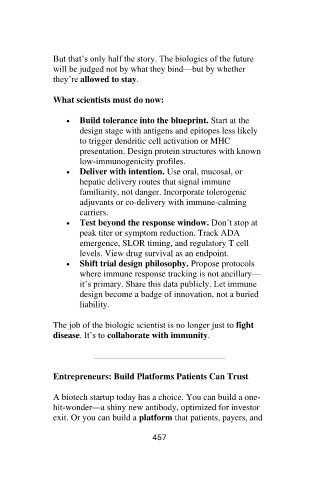Page 459 - Binder2
P. 459
But that’s only half the story. The biologics of the future
will be judged not by what they bind—but by whether
they’re allowed to stay.
What scientists must do now:
• Build tolerance into the blueprint. Start at the
design stage with antigens and epitopes less likely
to trigger dendritic cell activation or MHC
presentation. Design protein structures with known
low-immunogenicity profiles.
• Deliver with intention. Use oral, mucosal, or
hepatic delivery routes that signal immune
familiarity, not danger. Incorporate tolerogenic
adjuvants or co-delivery with immune-calming
carriers.
• Test beyond the response window. Don’t stop at
peak titer or symptom reduction. Track ADA
emergence, SLOR timing, and regulatory T cell
levels. View drug survival as an endpoint.
• Shift trial design philosophy. Propose protocols
where immune response tracking is not ancillary—
it’s primary. Share this data publicly. Let immune
design become a badge of innovation, not a buried
liability.
The job of the biologic scientist is no longer just to fight
disease. It’s to collaborate with immunity.
Entrepreneurs: Build Platforms Patients Can Trust
A biotech startup today has a choice. You can build a one-
hit-wonder—a shiny new antibody, optimized for investor
exit. Or you can build a platform that patients, payers, and
457

